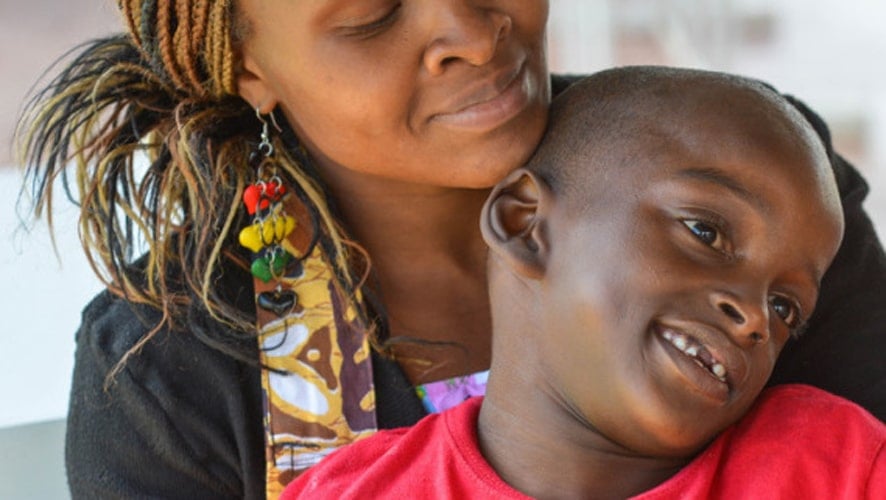
by Tara Wambugu | Apr 7, 2016 | 2016, Africa, Caring, Child Care, Children with Disabilities, Disability, Helping, Kenya, Kids, World Motherhood
My mom was visiting with us in Kenya recently, and I decided to take her to Heshima’s Dignity Designs, a specialty jewelry shop I had heard great things about. I thought it would be a fun mother-daughter day out, and we could buy some lovely African beaded jewelry. What I didn’t realize was that we were about to learn about an inspirational program supporting special needs children in Kenya.
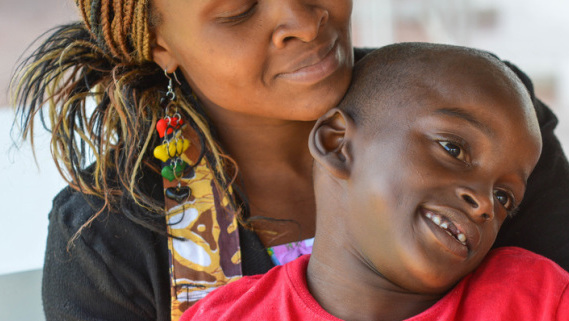
When we arrived at the shop, we met Heshima founder Tracey Hagman. She asked if we would like a tour of their children’s center before we started shopping, and we said, “Sure!” What we saw there touched and inspired us both.
Many special needs children in Kenya live a life with little dignity, and even less support. Heshima, meaning “dignity” in Swahili, provides assistance and services for Kenyan children with special needs, as well as their mothers.
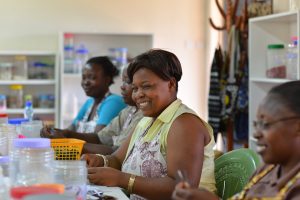
Kenya sorely lacks institutions providing services for children with disabilities. Many special needs children in Kenya are kept at home, out of school, sometimes hidden from the community due to stigma. Those that do attend public school often languish, neglected, without any targeted assistance. Very few special needs children ever have the opportunity to receive the special education or therapy they need.
Heshima seeks to meet the needs of such children – children with cerebral palsy, cognitive impairment, physical and learning disabilities, epilepsy, and other conditions.
Heshima provides meals, basic education, and specialized therapy (physical, occupational and speech) to the special needs children in their center. Heshima also supports the mothers of each enrolled child, providing them with training, employment, and much-needed income. Heshima moms are employed as water distributors, jewelry makers, or as assistants within the Heshima program.
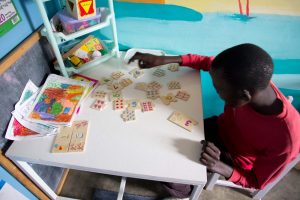
We got a chance to meet many of Heshima’s children, moms and staff during our visit that day. The center is beautiful – bright, cheery, and full of brightly colored toys, bean bags, and books. The children were so HAPPY. As we passed through the center, some children were contentedly napping. Other children were starting their therapy sessions, using both locally made and imported devices to help the children develop their gross and fine-motor skills. Still other children were sitting in class, working on their handwriting or listening to stories. It was a warm, welcoming space full of smiles and cheer. I felt good just being there.
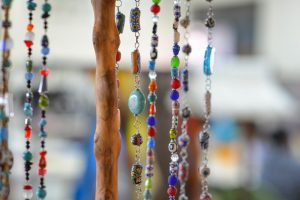
After we toured the center, we made our back to our original destination – the Dignity Designs jewelry shop, and picked up several gorgeous pieces. The proceeds from jewelry sales all go towards salaries for the Heshima moms, giving them the income they need to support their family. The jewelry is truly beautiful and unique!
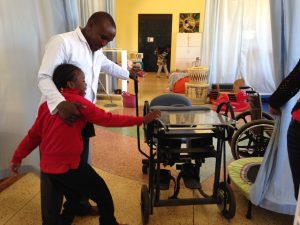
I was so inspired to see the work that Heshima is doing with these wonderful kids. These children deserve love and support. They deserve to be seen for who they are as individuals – not as labels, stereotypes, or stigma. Their moms deserve to make a living wage, and to connect with and get support from other moms going through the same challenges. Thanks to Heshima, they’re getting all this, and more.
If you would like to support the work done at Heshima, you can visit their website to make a donation. The center operates almost exclusively on individual donations, and relies heavily on the support of people like us!
Are quality services for special needs children available where you live? What is being done locally to support people with disabilities in your country?
This is an original post to World Moms Blog by Tara Wambugu. Follow Tara and her family’s adventures on her blog, Mama Mgeni, and connect with her on Facebook, Instagram, and Twitter.
Photo credits: Heshima, used by permission.
Tara Wambugu is a wife, a mother of two, and a Kenya-based lifestyle blogger covering parenting, family life, travel, and more. A former aid worker, Tara has worked in various countries in Europe, Central Asia, Africa, and Central America. She is now a stay-at-home mom living in Nairobi with her husband and their two sassy little girls. You can follow Tara and her family’s adventures on her blog, Mama Mgeni.
More Posts - Website
Follow Me:






by World Moms Blog | Mar 22, 2016 | 2016, Africa, Maternal Health, Mission Motherhood, Water
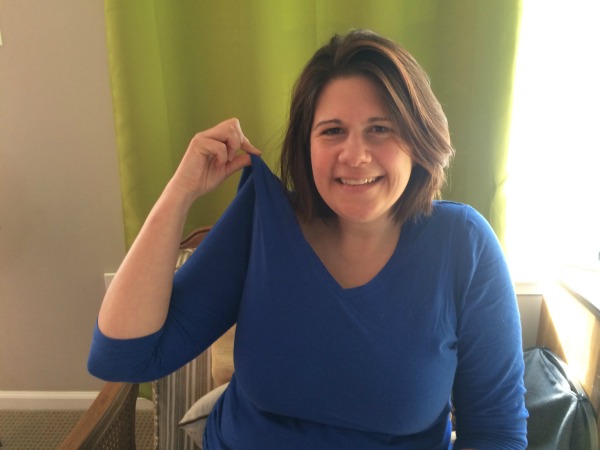
As part of World Moms Blog’s collaboration with BabyCenter’s Mission Motherhood™, our World Moms are writing posts on maternal health around the world. In today’s post, Jennifer Burden writes about the importance of clean water on maternal health in the developing world. She is wearing blue today to advocate for World Water Day!
“Water is an integral part of birthing around the world, yet many mothers lack access to it. In fact, an organization that works globally to help people gain access to clean water, WaterAID, recently ran a campaign linking motherhood and water access by comparing the things women packed in their maternity bags in the areas they serve around the world.
The post went viral.
With over 2 million estimated headline views and almost 17,000 Facebook shares, the story was carried on major web sites including BabyCenter!
What captured the interest of the masses? See for yourself…”
Read the full post, “Quick! Boil the water…she’s having the baby!” over at BabyCenter’s Mission Motherhood™!
Photo credit to: Sophie Burden
World Moms Blog is an award winning website which writes from over 30 countries on the topics of motherhood, culture, human rights and social good. Over 70 international contributors share their stories from around the globe, bonded by the common thread of motherhood and wanting a better world for their children.
World Moms Blog was listed by Forbes Woman as one of the "Best 100 Websites for Women 2012 & 2013" and also called a "must read" by the NY Times Motherlode in 2013. Our Senior Editor in India, Purnima Ramakrishnan, was awarded the BlogHer International Activist Award in 2013.
More Posts

by Jennifer Burden | Mar 7, 2016 | 2015, Africa, Maternal Health, Mission Motherhood
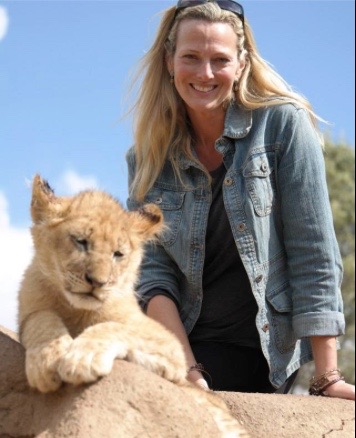
As part of World Moms Blog’s collaboration with BabyCenter’s Mission Motherhood™, our World Moms are writing posts on maternal health around the world. In today’s post, Elizabeth Atalay in the USA writes about the changes to her body during and after birthing and how the experience of birthing has united her to mothers who suffer from obstetric fistula in the developing world.
“Giving birth has a way of connecting women through an awakening of intimate understanding, also known as TMI (too much information)! We share stories with each other about topics previously unspeakable. Hemorrhoids! Incontinence! Milk leaking from breasts! Water breaking in public places! Yikes. The awe of pregnancy and the miracle of our bodies giving birth to new humans are intertwined with the humility it forces upon us like no other experience.”
Read the full post, “I never knew this could happen while giving birth“, over at BabyCenter’s Mission Motherhood™!

Jennifer Burden is the Founder and CEO of World Moms Network, an award winning website on global motherhood, culture, human rights and social good. World Moms Network writes from over 30 countries, has over 70 contributors and was listed by Forbes as one of the “Best 100 Websites for Women”, named a “must read” by The New York Times, and was recommended by The Times of India.
She was also invited to Uganda to view UNICEF’s family health programs with Shot@Life and was previously named a “Global Influencer Fellow” and “Social Media Fellow” by the UN Foundation. Jennifer was invited to the White House twice, including as a nominated "Changemaker" for the State of the World Women Summit. She also participated in the One Campaign’s first AYA Summit on the topic of women and girl empowerment and organized and spoke on an international panel at the World Bank in Washington, DC on the importance of a universal education for all girls. Her writing has been featured by Baby Center, Huffington Post, ONE.org, the UN Foundation’s Shot@Life, and The Gates Foundation’s “Impatient Optimists.” She is currently a candidate in Columbia University's School of International and Public Affairs in the Executive Masters of Public Affairs program, where she hopes to further her study of global policies affecting women and girls.
Jennifer can be found on Twitter @JenniferBurden.
More Posts - Website
Follow Me:


by Jennifer Burden | Feb 26, 2016 | 2016, Africa, Maternal Health, Mission Motherhood
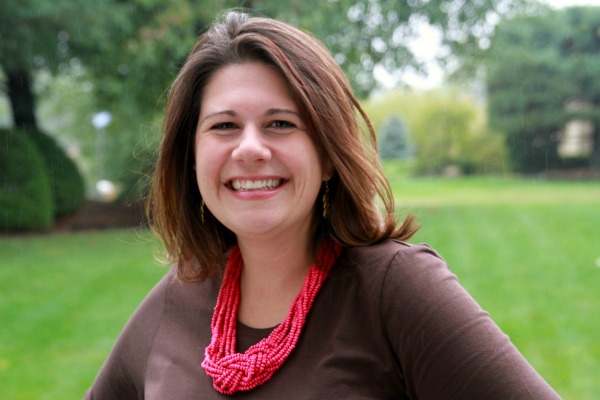
In collaboration with BabyCenter’s Mission Motherhood™, our World Moms are writing posts on maternal health around the world. In today’s post, Jennifer Burden in the USA writes about the differences between a prenatal checkup in rural Uganda after her trip there with Shot@Life in 2012.
“Have you ever gotten to the point where you feel like a regular in your OB/GYN’s office during prenatal visits? I remember my own visits, a few at first, and then, more and more as my due date approached. However, when I was last in Uganda, I met up with a nurse midwife and I asked her what a typical prenatal checkup is like for a mom in a rural area there. The differences surprised me more than I expected.”
Read the full post, “Prenatal Care in Uganda: 7 Differences that May Surprise You“, over at BabyCenter’s Mission Motherhood™!

Jennifer Burden is the Founder and CEO of World Moms Network, an award winning website on global motherhood, culture, human rights and social good. World Moms Network writes from over 30 countries, has over 70 contributors and was listed by Forbes as one of the “Best 100 Websites for Women”, named a “must read” by The New York Times, and was recommended by The Times of India.
She was also invited to Uganda to view UNICEF’s family health programs with Shot@Life and was previously named a “Global Influencer Fellow” and “Social Media Fellow” by the UN Foundation. Jennifer was invited to the White House twice, including as a nominated "Changemaker" for the State of the World Women Summit. She also participated in the One Campaign’s first AYA Summit on the topic of women and girl empowerment and organized and spoke on an international panel at the World Bank in Washington, DC on the importance of a universal education for all girls. Her writing has been featured by Baby Center, Huffington Post, ONE.org, the UN Foundation’s Shot@Life, and The Gates Foundation’s “Impatient Optimists.” She is currently a candidate in Columbia University's School of International and Public Affairs in the Executive Masters of Public Affairs program, where she hopes to further her study of global policies affecting women and girls.
Jennifer can be found on Twitter @JenniferBurden.
More Posts - Website
Follow Me:


by Nicole Melancon (USA) | Feb 16, 2016 | 2016, Africa, Malaria, Social Good, World Voice
“If you think you’re too small to make a difference you haven’t spent a night with a mosquito”.‐ African proverb
The figures are staggering. According to the World Health Organization: “About 3.2 billion people – nearly half of the world’s population – are at risk of malaria. In 2015, there were roughly 214 million malaria cases and an estimated 438,000 malaria deaths. Sub-Saharan Africa continues to carry a disproportionately high share of the global malaria burden. In 2015, the region was home to 89% of malaria cases and 91% of malaria deaths. In areas with high transmission of malaria, children under 5 are particularly susceptible to infection, illness and death. More than two-thirds (70%) of all malaria deaths occur in this age group. In 2015, about 305,000 African children died before their fifth birthdays” making malaria the leading killer of children in Africa. (Source: WHO 2015 statistics).
Although these figures are frightening, what is even more shocking is that these deaths are entirely preventable. Per the World Health Organization, “Increased prevention and control measures have led to a 60% reduction in malaria mortality rates globally since 2000”. This is amazing progress that brings hope that we will be able to wipe malaria off the face of the earth forever.
Eradicating malaria is the dream of South African-based Goodbye Malaria, an organization I interviewed to learn how a team of African entrepreneurs, predominantly women sprayers and socially minded businesses, are coming together to “save a life in your sleep” and eradicate malaria in their lifetime. Here’s their story.
Goodbye Malaria began as a dream of successful African entrepreneur, Robbie Brozin, founder of Nando’s food chain. Robbie traveled throughout the African continent with Humanitarian adventurer, Kingsley Holgate, who is known as the most traveled man in all of Africa. During their travels, Robbie realized that malaria was killing so many people and no one was doing anything about it. In fact, malaria is the number one killer of children in Africa, yet is entirely preventable.
Inspired to do good and fight to end malaria, Brozin along with three other African entrepreneurs founded Goodbye Malaria in February 2013. Goodbye Malaria helps to raise funds to support on the ground malaria elimination programs in Mozambique, to educate and advocate against malaria all while creating employment across the continent. Their beautiful online shop which sells products that “save a life in your sleep” offers African-made pajamas, bracelets, slippers, pencil boxes and teddy bears, all which employ local women and protect families in Mozambique against malaria.
How it works:
Goodbye Malaria employs a crew of both male and female sprayers (over 70% of the sprayers are women) who go house to house within the communities and spray the inside of the homes with a specially formatted insecticide to kill malaria-transmitting mosquitoes. Goodbye Malaria provides extensive training for the sprayers whose job is not easy. They must wear heavy, protective uniforms and masks in often very hot weather. Yet, the job is rewarding and there has been much success. In Southern Mozambique’s Maputo Province, the results from a preliminary pilot project from the first Goodbye Malaria spray round started in October 2013 show that the population of Boane district has been protected for two consecutive years, and prevalence has been reduced by 70%.
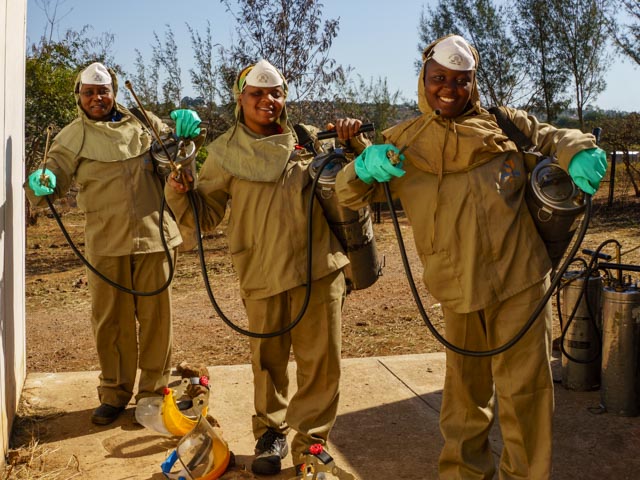
Goodbye Malaria Women Sprayers
Why Mozambique?
Although Goodbye Malaria is based in South Africa, South Africa does not have malaria. Mozambique was a logical place for Goodbye Malaria to start their work since it borders South Africa, has a high rate of malaria transmission, and also has special ties with the Nandos and Goodbye Malaria founder Robbie Brozin. Nando’s famous chicken originated in Mozambique. Their award-winning “peri-peri” sauce is made from red hot chilis grown there. Goodbye Malaria works directly with the government of Mozambique and other non-profit organizations on the ground in two large areas of the country. Roughly 200,000 people have been impacted by their work yet there is much more to do.
“Save a Life in your Sleep”:
Goodbye Malaria operates as a Social Benefit Organization (SBO) not a NGO (non-governmental organization) meaning in addition to outside funding, they also use profits from products to go directly to support their operations on the ground. Goodbye Malaria’s tagline is “Save a Life in your Sleep”. By shopping at Goodbye Malaria’s online store, your purchase helps in two ways. First, by creating jobs that support local South African entrepreneurs. Second, the proceeds directly fund the spray program in Mozambique.
The head of Goodbye Malaria’s merchandizing, Kim Lazarus explained that the products are all about changing lives and saving lives. There is a link between how woman in South Africa are making products that will make a difference in the lives of their sisters in Mozambique. It is a wonderful concept.
The products:
The online shop at Goodbye Malaria offers some wonderful products for sale and provides shipping right in the US. Every product is made in South Africa, and the products are 100% transparent, sustainable and ethically sourced.
 Homemade “Shwe Shwe” pajama bottoms: Shwe Shwe is a popular South African fabric. It is bright, colorful and authentic. The idea behind the pajamas is that you are covered at night while someone else sleeps safely at night in Mozambique (as mosquitos mostly bite at night). They also make pencil boxes, hats, and slippers out of the same cotton fabric.
Homemade “Shwe Shwe” pajama bottoms: Shwe Shwe is a popular South African fabric. It is bright, colorful and authentic. The idea behind the pajamas is that you are covered at night while someone else sleeps safely at night in Mozambique (as mosquitos mostly bite at night). They also make pencil boxes, hats, and slippers out of the same cotton fabric.
Teddy Bears: The homemade teddy bears are another special story. Each bear is unique and made by a different woman. The bears are called the “Mashozi” bear which means “the woman wears the pants”. The name came after Kinsley’s late wife who was an inspiration.
Bracelets: The Goodbye Malaria bracelets are made by the “go gos” – a term used for grannies who watch children who lost their parents from HIV/AIDS. Making the beads and bracelets provides them with extra income and they also involve the children in the process.
I thoroughly enjoyed my Skype call with co-founder Kim Lazarius. When I ended the call, I sat in wonder and amazement feeling completely inspired that there are such amazing people in the world doing good and saving lives, with passion. I instantly ordered a pair of Goodbye Malaria pajama bottoms for myself for the holidays. When I wear them, I can think about how fortunate I am to not have to worry about malaria but also that I’m hopefully saving a life while I sleep.
To learn more about Goodbye Malaria, click here. To view their online shop, click here.
This is an original post written for World Moms Blog by Nicole Melancon of ThirdEyeMom.com.

Third Eye Mom is a stay-at-home mom living in Minneapolis, Minnesota with her two children Max (6) and Sophia (4). Her children keep her continually busy and she is constantly amazed by the imagination, energy and joy of life that they possess! A world wanderer at heart, she has also been fortunate to have visited over 30 countries by either traveling, working, studying or volunteering and she continues to keep on the traveling path.
A graduate of French and International Relations from the University of Wisconsin Madison, where she met her husband Paul, she has always been a Midwest gal living in Minnesota, Wisconsin and Chicago. This adventurous mom loves to be outside doing anything athletic (hiking, running, biking, skiing, snowshoeing or simply enjoying nature), to travel and volunteer abroad, to write, and to spend time with her beloved family and friends.
Her latest venture involves her dream to raise enough money on her own to build and open a brand-new school in rural Nepal, and to teach her children to live compassionately, open-minded lives that understand different cultures and the importance of giving back to those in need. Third Eye Mom believes strongly in the value of making a difference in the world, no matter how small it may be. If there is a will, there is a way, and that anything is possible (as long as you set your heart and mind to it!).
Visit her on her blog, Thirdeyemom, where she writes about her travels and experiences in other lands!
More Posts

by Tara Wambugu | Feb 11, 2016 | 2016, Africa, Kenya, Tara Wambugu, World Motherhood
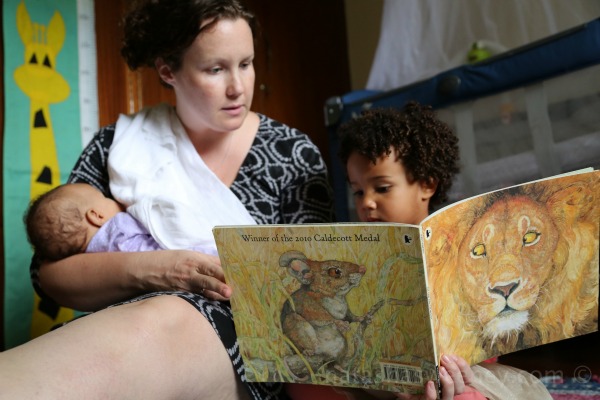
We are big readers in our house, and we have proudly curated a wonderful collection of books for our girls. Both my husband and I want to be sure that our children are strongly exposed to both Kenyan and American culture, so we have made sure we have plenty of books in our collection about life in Kenya and Africa at large. Here are a few of our favorites!
For You are a Kenyan Child, by Kelly Cunnane and Ana Juan
For You are a Kenyan Child is a lovely story about a Kalenjin boy who lives in a rural Kenyan village. He has been given the job of minding his grandfather’s cattle for the day, but he becomes so distracted by all the goings-on in the village that he loses track of the herd. My eldest daughter loves the part when the boy realizes he’s lost track of his grandfather’s cows, and he imagines all the trouble they may have gotten into. I love when he almost knocks down a beautiful Pokot girl and a plump mama carrying mangoes while trying to get back to the grazing cows. Luckily, his wise grandfather knows just where to find them! The illustrations in this book are truly beautiful, and we just love the story.
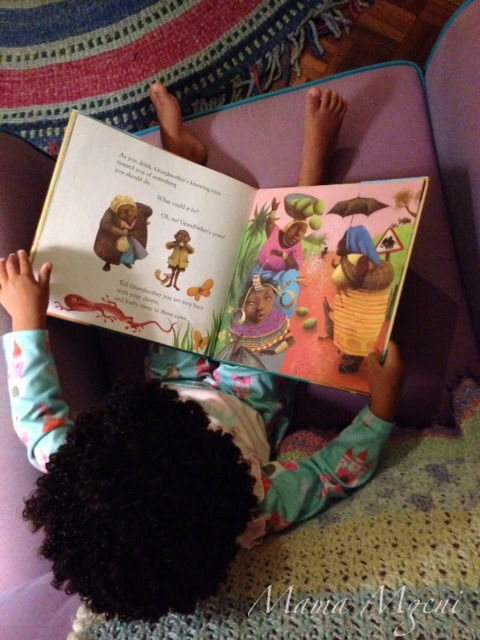
Chirchir is Singing, by Kelly Cunnane and Jude Daly
Chirchir is Singing is the story of Chirchir, a young Kalenjin girl who loves to sing, and wants to help her family with all their work. She tries to help her mother bring water from the well, but drops the bucket. She tries to help her grandmother make the tea, but accidentally puts out the fire. She tries to help her sister mud the floor, but sneezes and makes a mess. Slowly, Chirchir stops singing, and her smile turns to a frown. But soon she finds exactly how she can help, and her family realizes just how wonderful her singing is.
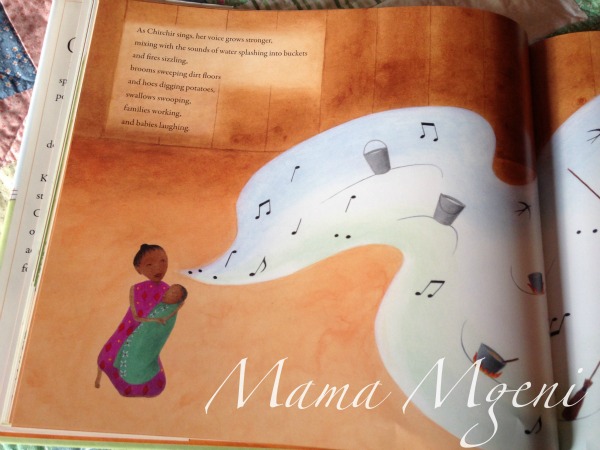
Moja Means One, by Muriel Feelings and Tom Feelings
Moja Means One is a simple Kiswahili counting book, and it’s great for even very young children. It not only teaches children how to count to ten in Kiswahili, but it also describes important African cultural practices, like the way mothers carry their babies on their backs in a simple cloth, the oral tradition of storytelling in the rural villages, and different kinds of traditional African clothing. Both of my children are learning Kiswahili from their father, but it’s so nice to have a book that emphasizes their African heritage!
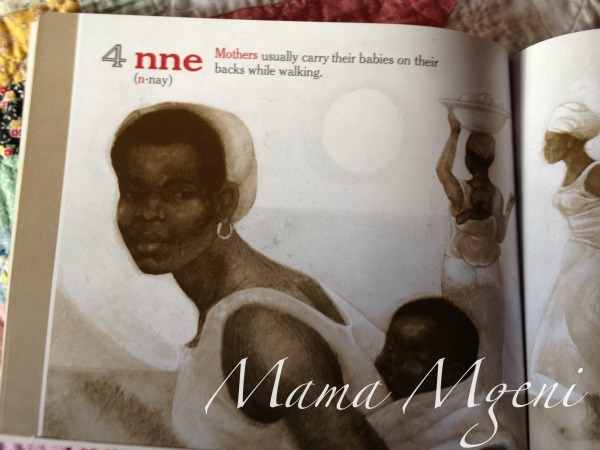
Lila and the Secret of Rain, by David Conway and Jude Daly
This is the story of a young girl in a rural Kenyan village afflicted by drought. The sun beats down on the village, and it is too hot to gather firewood, too hot to weed the garden, and too hot to milk the cow. Young Lila learns from her grandfather the secret of the rain, and she sets out to save her village and bring the rains. She climbs the highest mountain she can find, and begins to tell the sky the saddest things she knew. At last, she laments that without water, there can be no life, and her village is at risk. The sky grows darker, full of Lila’s sadness, and the rain begins to fall. Only Lila and her grandfather know the secret of what brought the rains.
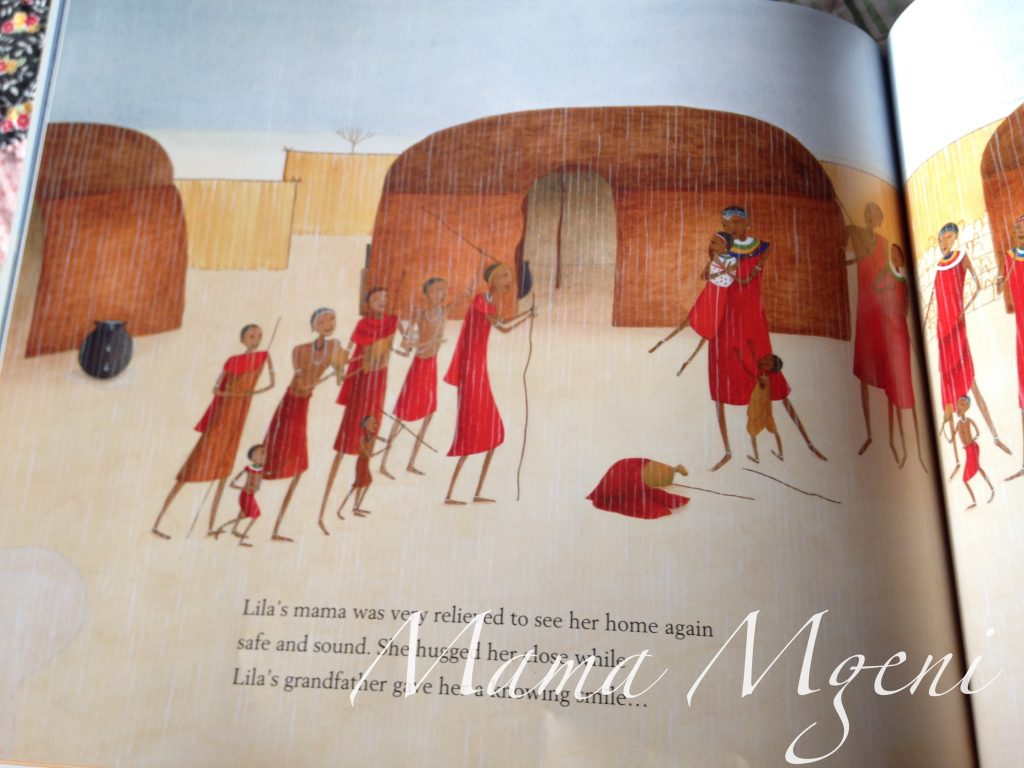
Into the Bush, by Sandra Arensen
Into the Bush is a story is about a young girl named Lilee and her adventures on safari with her family. The tale is vividly told – you can almost hear the sound of the hyenas crunching on bones, or the snap of the crocodile’s jaws in the river below. What I love most about this book are the amazing illustrations. Sandra Arensen does her own artwork using watercolors, and her use of striking lines and vibrant color reminds me of spectacular stained glass windows. My children love the story and the illustrations, and my eldest always talks about her own safari experiences when we read it!
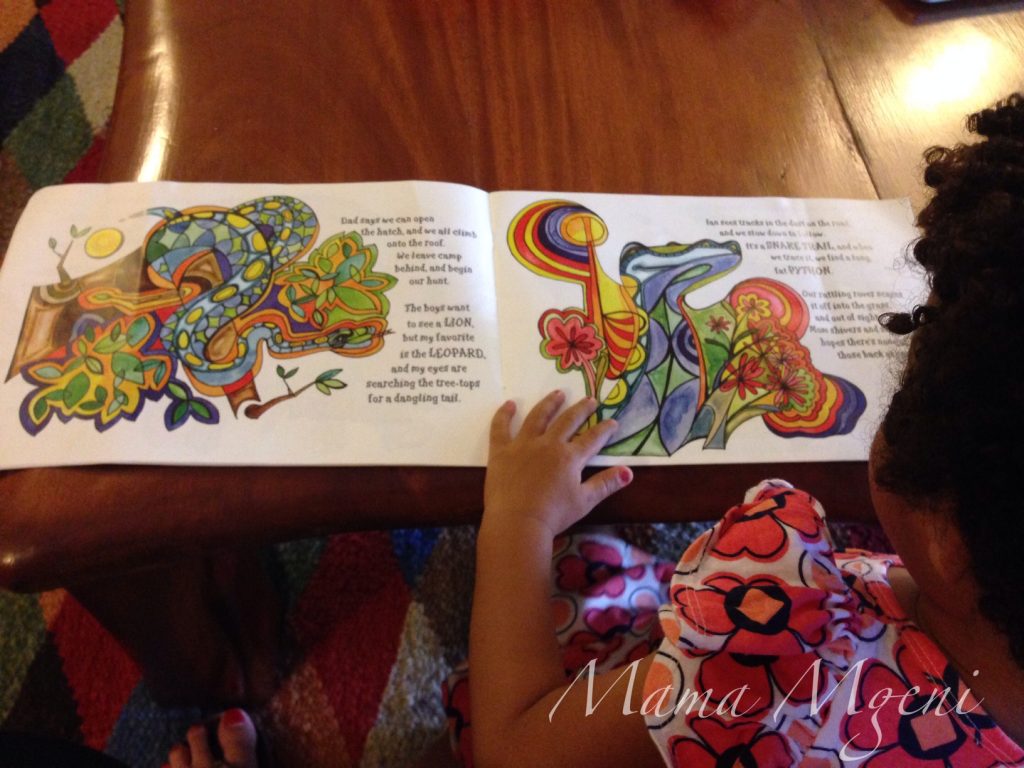
“Into the Bush” isn’t available online, but you can send an email to the publisher at editorial@oldafricamagazine.com, if you are interested in purchasing it. The cost of $10 USD covers the book and shipment in the USA. Please let them know what country you are in, so they can give you the proper pricing!
The Lion and the Mouse, by Jerry Pinkney
Jerry Pinkney illustrated his beautiful adaptation of Aesop’s famous fable about acts of kindness. There are no words in this book – it is up to parents to narrate the story based on the powerful illustrations. We all know the tale: a fierce lion decides to spare the life of a timid field mouse who wakes him from his sleep. Later, the tiny mouse comes to the lion’s rescue, freeing him from a poacher’s net. The moral of the story, of course, is that no good deed goes unrewarded, and that all creatures – great and small – can help one another.
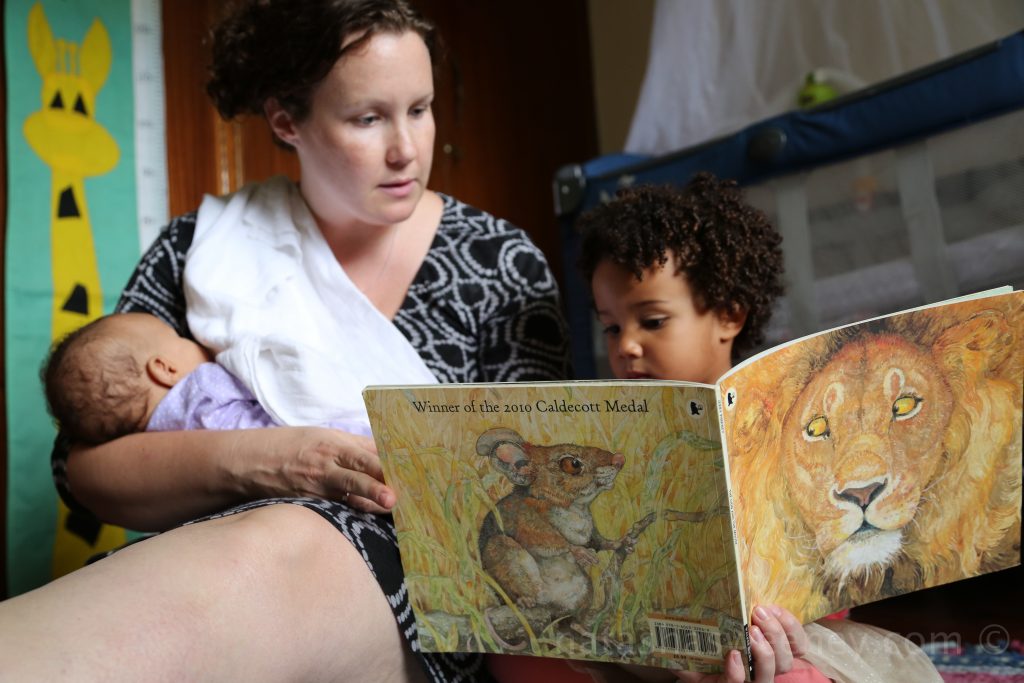
Safari ya Angani, by Francis Atulo
This is a story of the once-beautiful tortoise who wished to fly with the crows into the sky to eat the clouds. One day, the crows carry him up into the sky, as the tortoise sings, “Tunaenda kula mawingu,” (We’re going to eat the clouds!). But the crows lose their grip, and the tortoise falls down to Earth, landing on his back and cracking his beautiful shell. This story is told in simple Kiswahili, and our girls love to sing with the tortoise!
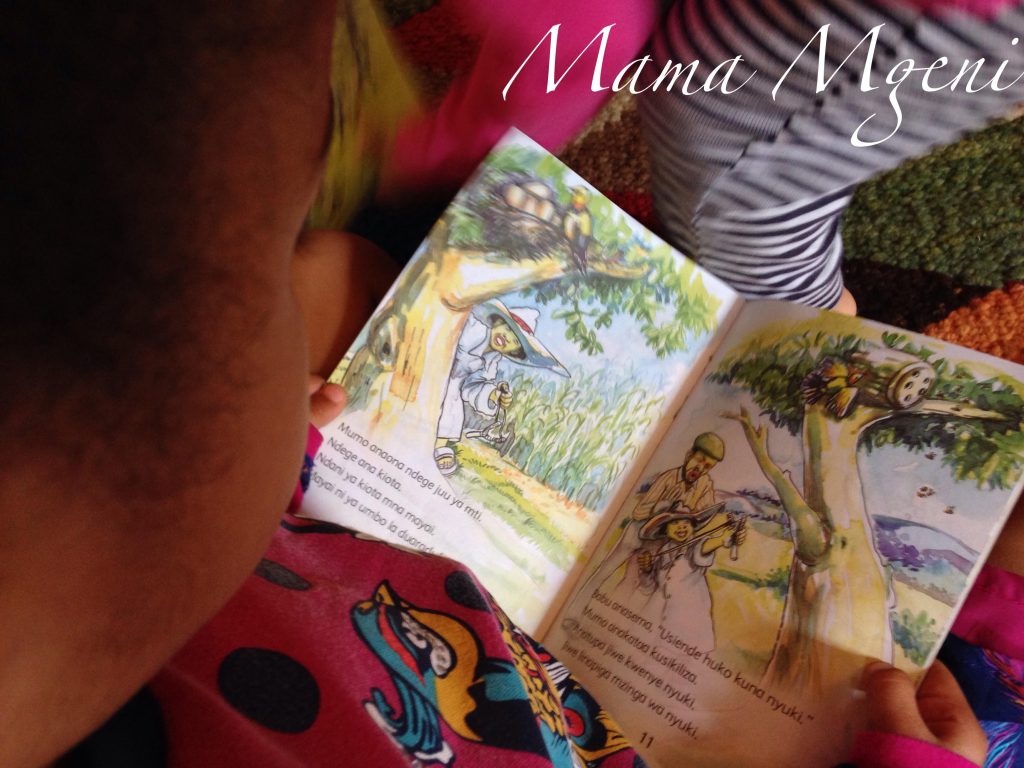
Opulo Aenda Safari by Frank Odoi
The story of a rat named Opulo, who used to have a beautiful, fluffy tail and a nice Maasai blanket to wear on his shoulder. But Opulo is stubborn, and he refuses advice from friends when he sets off on a journey. He winds up walking straight into a thunderstorm, and ultimately loses both his beautiful clothing and his fluffy tail, and learns an important lesson.
Shambani kwa Babu by Hassan Makombo
The story of a young boy named Mumo who goes to the village to visit his grandparents. While helping his grandfather in the garden, he shoots at a bird’s nest with his slingshot, and disturbs a nest of bees. His wise grandfather quickly fans the fire, and uses the smoke to chase away the bees, and Mumo learns an important lesson.
We want our children to see themselves in the books we read, and these tales of life in Kenya definitely give our kids a chance to identify with their Kenyan culture and heritage. Since we live in Nairobi, the capital city of Kenya, our girls aren’t always exposed to traditional life in the rural villages. We love the traditional tales spun in these stories!
Do you read your children stories about their native country and culture? What are your favorites?
This is an original post to World Moms Blog by Tara Wambugu. Follow Tara and her family’s adventures on her blog, Mama Mgeni, and connect with her on Facebook and Twitter.
Photos for The Lion and the Mouse by Natasha Sweeney, used with permission. All other photos credited to the author.
Tara Wambugu is a wife, a mother of two, and a Kenya-based lifestyle blogger covering parenting, family life, travel, and more. A former aid worker, Tara has worked in various countries in Europe, Central Asia, Africa, and Central America. She is now a stay-at-home mom living in Nairobi with her husband and their two sassy little girls. You can follow Tara and her family’s adventures on her blog, Mama Mgeni.
More Posts - Website
Follow Me:

























 Homemade “Shwe Shwe” pajama bottoms: Shwe Shwe is a popular South African fabric. It is bright, colorful and authentic. The idea behind the pajamas is that you are covered at night while someone else sleeps safely at night in Mozambique (as mosquitos mostly bite at night). They also make pencil boxes, hats, and slippers out of the same cotton fabric.
Homemade “Shwe Shwe” pajama bottoms: Shwe Shwe is a popular South African fabric. It is bright, colorful and authentic. The idea behind the pajamas is that you are covered at night while someone else sleeps safely at night in Mozambique (as mosquitos mostly bite at night). They also make pencil boxes, hats, and slippers out of the same cotton fabric.











